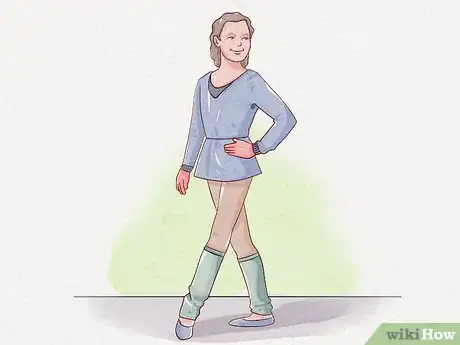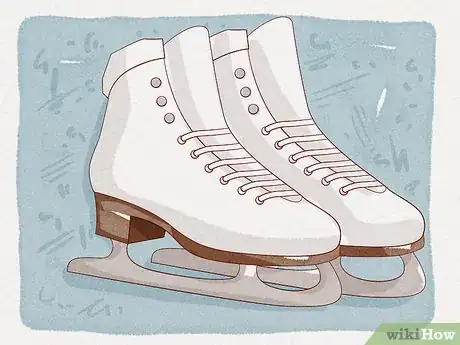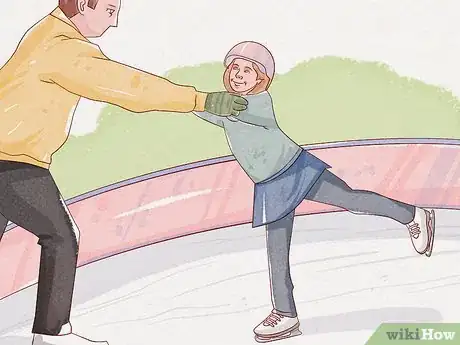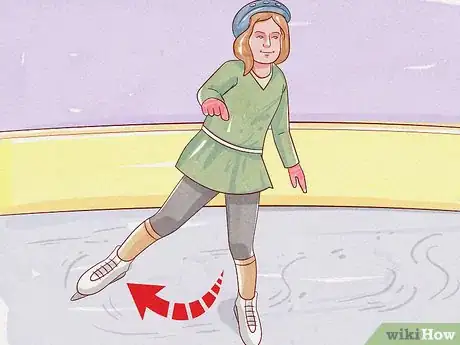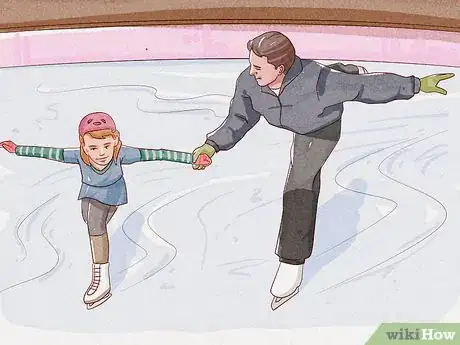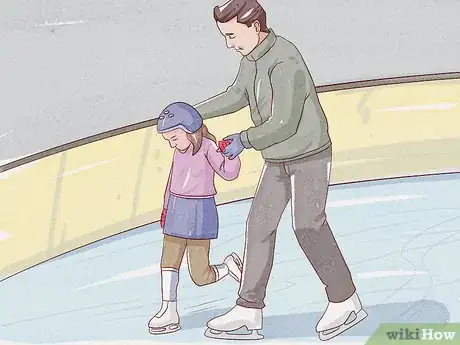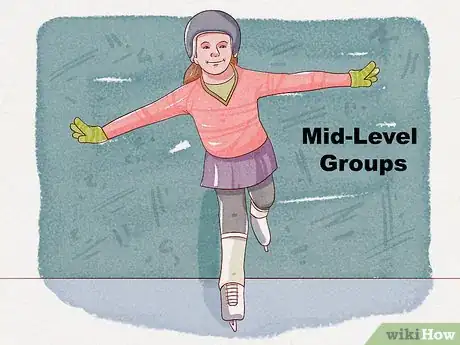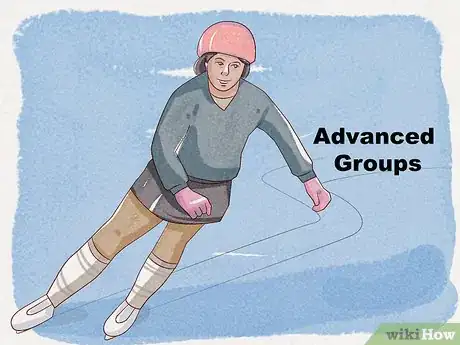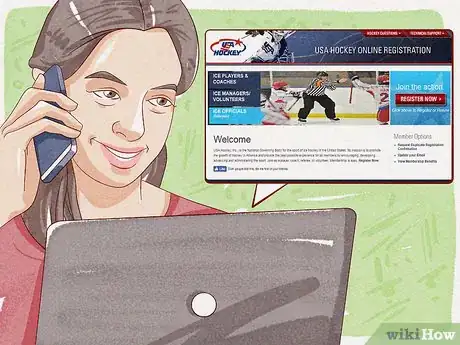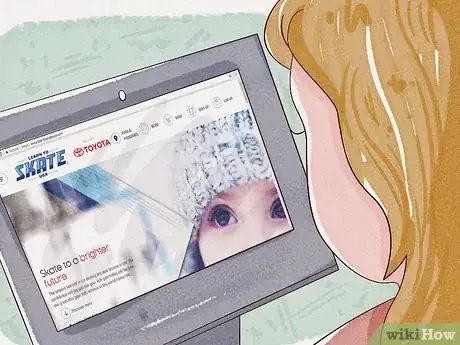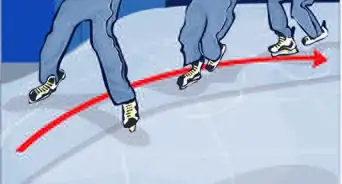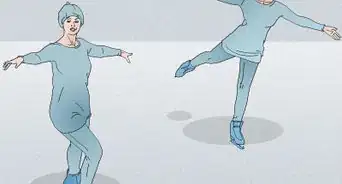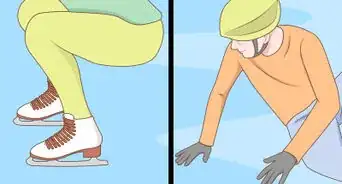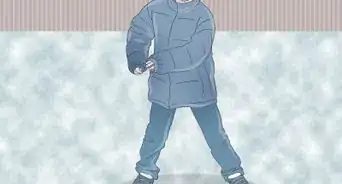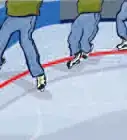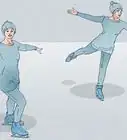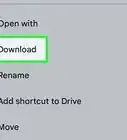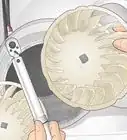This article was co-authored by wikiHow Staff. Our trained team of editors and researchers validate articles for accuracy and comprehensiveness. wikiHow's Content Management Team carefully monitors the work from our editorial staff to ensure that each article is backed by trusted research and meets our high quality standards.
This article has been viewed 15,620 times.
Learn more...
Ice skating is a pastime that many people across the world enjoy. For parents looking to spend some quality ice time with your kids, you’ll want to get them prepared with proper clothes and skates, then practice some basic skills with them. If you’re a skilled skater who is interested in teaching professionally, you’ll want to develop lessons for varied skill levels and reach out to organizations about becoming a certified instructor.
Steps
Showing Your Kids Some Basics
-
1Dress them in the right clothes and gear. Skip dressing your child in a snowsuit unless you’re going to be outdoors in subzero temperatures. For most skating sessions, layers of lightweight shirts and leggings or sweatpants, a pair of tall lightweight socks, a jacket, and gloves are appropriate.[1]
- Don’t dress them in layers of thick socks. Doing this can cut off circulation to their feet. Also, jeans can get uncomfortable pretty quickly during sessions because they restrict movement. Stick to leggings and sweatpants.
- Gloves are important for protecting your child’s fingers from cold and from injuries from skates. A thick pair of waterproof gloves are best to wear during skate sessions.
- Your very young child or child who’s brand new to the ice should wear a helmet and knee pads. A bicycle helmet works fine if you don’t have access to a hockey helmet.
-
2Fit them in the right skates. Whether you’re renting skates at the rink or looking to buy a pair, you’ll want to make sure they’re the right size. Start by having your child try on skates that are in their shoe size, then move up or down a size if needed. The skates should be tight on their feet and their feet should not be able to slide around inside the skate at all.[2]
- When your child’s skates are laced up, they should be standing straight up, their heels should be up against the back of the skate, and they should be able to wiggle their toes. If their ankles are curving in or out, the skates may not be laced tight enough or the skates may be too big.
- Choose lace-up skates or Velcro over the rigid boot style skates with buckles. These buckles can become undone if your child falls.
Advertisement -
3Teach your child to fall correctly first. Any new skater is going to spend some time falling. Teach your child to bend their knees when they think they may be starting to fall. Then, have them lean to 1 side and go down to the ice gently.
- To get back up, have your child kneel on both knees and then lift 1 leg up and put the skate on the ice. Have them push down on that knee with their hands while pulling themselves back up to standing.
-
4Practice small steps. Have your child lift 1 foot, put it down, then lift the other foot. This helps give them a sense of the blade on the ice and shifting their weight. Have them bend their knees and keep their hands out in front and pushing down, as if pushing on an invisible table, to maintain their balance.
- Stand to the side or in front of your child with your hands under both their hands. Avoid holding just 1 of their hands, as it may throw off their balance.
-
5Let them glide gradually. Once your child gets the hang of taking small steps on the ice, you can show them how to push off with 1 skate into a glide. With their knees bent and feet together, have them bring 1 skate behind them and push off with the inside edge of that blade.
- Your child may enjoy just walking on the ice close to the rink’s edge at first, catching onto the rail when they feel off balance. This is fine; allow them to practice being comfortable on the ice.
-
6Show them how to stop. While standing with their feet together, show your child how to push out the inside edge of each blade to get a feel for shaving the ice, or scraping the ice surface with the side of their blade. Tell them that this is what they will do with 1 foot while stopping. Have them go into a slow glide, then bend their knees and bring their toes to an inverted “V,” while putting their weight on 1 foot and shaving the ice to stop with the other.
- Have your child push down with their hands, as if pushing on an invisible table, to maintain their balance while practicing stopping.
-
7Keep encouraging them and keep lessons short. Remind your child that ice skating is hard, that it takes a lot of practice to get better, and that they’re doing great. Try to keep lessons to around 25 minutes in the beginning to avoid having them get too tired. They are more likely to get hurt if they push themselves too hard when they’re tired.[3]
- Encourage them to try new things each lesson, such as staying away from the edge. When they can easily do 25-minute lessons without getting tired, they may be ready for longer lessons.
Teaching Ice Skating Classes
-
1Reach out to a rink in your area. To get started teaching classes, find out the requirements for teaching at your local ice rink. You will most likely need to pass a background check, have liability insurance, and get a basic skills instructor membership documented by the Professional Skater’s Association (PSA) to teach basic skills courses.
- Visit the PSA website for more information on the background checks, insurance, and membership needed for teaching basic skills.
- Teaching more advanced specialty courses such as figure skating, hockey, or speed skating will require more technical training and certification.[4]
-
2Teach beginners basic skills centered around balance and stopping. Have beginners do standing activities like Simon says, and hokey pokey to improve their balance. Include basic movement activities that involve walking on ice and slow gliding. Have them “make snow” with the ice by practicing the stopping technique of sliding 1 skate blade out while keeping their weight on the other foot.[5]
- Other good activities for beginners include fetch games, follow the leader, and ring around the rosie.
-
3Organize coordination activities for mid-level groups. Activities like obstacle courses and baseball on ice are great games for improving coordination with mid-level groups. You can also build upon fetch games used in beginner classes; just have them bring the objects back faster. Have mid-level students pair off and toss a squishy ball back and forth between each other while gliding.[6]
- Mid-level students are students who can walk and move around on the ice, get up on their own, play basic movement games, and can stand or skate on 1 foot for a short period of time.
- Other game ideas for this group include fill-the-bucket relay and follow the leader incorporating skating on 1 foot.
-
4Have advanced groups practice drills and speed games. Advanced level groups generally can glide and stop well, can transfer their weight between skates easily, and can move backwards. Drills like suicides and speed games like relay races work well with this group. They may also enjoy playing soccer on ice and keeping a balloon in the air from 1 end of the rink to the other in small groups.[7]
- For basic suicide drills, set up cones at the corners of the rink and have students sprint-skate to each cone, stop, then go the next cone. Stagger students in pairs to prevent colliding. Continue for 10 minutes or until each student has done 5-10 laps.
- Other games for this group include red light – green light and obstacle courses that include jumping.
Becoming a Certified Coach or Instructor
-
1Contact U.S. Figure Skating to teach figure skating professionally. If you’re interested in coaching figure skating, check out the U.S. Figure Skating website about the process of becoming a coach. You will probably start with becoming a certified Basic Skills Instructor first. To become certified to coach entrants in qualifying and non-qualifying competitions, test sessions, or ice shows or carnivals, you will need to get additional certification.
- Professional figure skating coaches also need to complete yearly training in courses such as professional ethics, sports safety and science, and U.S. figure skating rules. Information on how to complete these trainings is available through the U.S. Figure Skating website.
- U.S. Figure Skating certifies instructors and coaches through the Professional Skater’s Association.
-
2Call your local rink or school district about coaching hockey. For coaching recreational or high school hockey teams, find out the requirements at your local rink, rec center, or school district. Your requirements may include experience playing on a team and assistant coaching, registering through USA Hockey, and taking other safety training courses such as equipment safety and concussion safety.
- The USA Hockey website is at https://www.usahockeyregistration.com/login_input.action.
-
3Check out Learn to Skate USA for additional useful information. Learn to Skate USA is a major organization offering pre-professional classes ranging from basic skills to specialties like figure skating, hockey, speed skating, synchronized skating, and theater on ice. They offer classes for kids and adults, from beginner to advanced levels. You can take classes through them to gain additional required experience, or teach classes through them.
- Learn more about certified coaching requirements by becoming an involved member. Visit the Learn to Skate USA website at https://www.learntoskateusa.com/ for more information.
References
- ↑ https://www.parentmap.com/article/tips-for-teaching-kids-to-ice-skate
- ↑ https://www.todaysparent.com/kids/preschool/what-to-know-when-teaching-your-toddler-to-ice-skate/
- ↑ https://www.todaysparent.com/kids/preschool/what-to-know-when-teaching-your-toddler-to-ice-skate/
- ↑ http://sk8stuff.com/f_basic_ref/certification_of_skating_instructors.htm
- ↑ http://speedskatenb.ca/wp-content/uploads/2015/06/teachingthebasics.pdf
- ↑ http://speedskatenb.ca/wp-content/uploads/2015/06/teachingthebasics.pdf
- ↑ http://speedskatenb.ca/wp-content/uploads/2015/06/teachingthebasics.pdf
